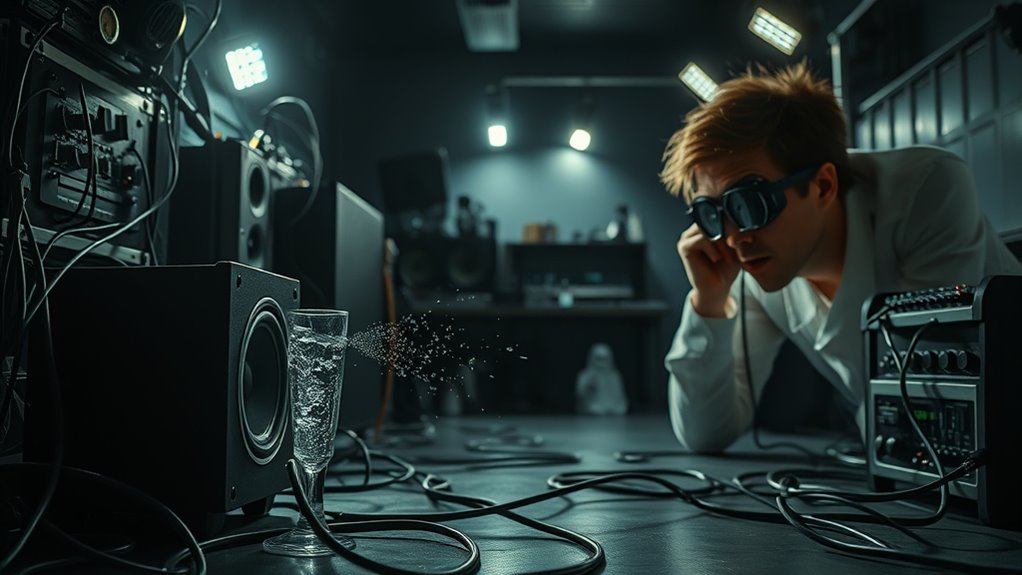Yes, infrasound can cause feelings often perceived as paranormal. With frequencies below 20 Hz, infrasound triggers anxiety and panic in many individuals. Studies show that around 22% of people report unusual experiences when exposed to it, particularly in places thought to be haunted. Vic Tandy’s research links these unsettling feelings to physiological reactions caused by low-frequency sounds. If you’re curious about how infrasound intertwines with these eerie encounters, there’s much more to discover.
Key Takeaways
- Infrasound, with frequencies below 20 Hz, can provoke significant psychological reactions like anxiety and fear, often associated with paranormal feelings.
- Studies show that 22% of participants reported unusual experiences when exposed to infrasound, suggesting a link to feelings of unease in haunted locations.
- Vic Tandy’s research indicated that infrasound could affect the human eyeball’s resonance, leading to visual distortions often interpreted as paranormal phenomena.
- Infrasound is commonly found in allegedly haunted sites, supporting the idea that environmental factors can influence perceptions of the supernatural.
- Ongoing research continues to explore how infrasound interacts with psychological suggestibility in creating experiences perceived as paranormal.
Understanding Infrasound and Its Sources

When you think about sound, you might imagine the melodies of your favorite song, but infrasound operates below the threshold of human hearing, with frequencies under 20 Hz that can still profoundly affect you.
This low-frequency sound can come from various sources, both natural and industrial. Thunderstorms and ocean waves create infrasound, while elephants and dolphins use it for communication.
You might encounter infrasound in haunted locations, where industrial machinery or extractor fans inadvertently produce these frequencies.
Research shows that infrasound can induce feelings of anxiety and unease, making you question your surroundings. This phenomenon could explain why some experiences in supposedly haunted places feel so intense, blurring the line between reality and the paranormal.
The Psychological Effects of Infrasound

Although you can’t consciously hear infrasound, its impact on your mind and body is undeniable. This low-frequency sound, below 20 Hz, can provoke significant psychological reactions, including anxiety, fear, and unease. Research shows that exposure to infrasound can lead to feelings of panic and perceptual distortions, like visual disturbances or a sensation of being watched. In a study of 750 participants, 22% reported unusual experiences, such as chills or revulsion, during infrasound exposure at a concert. These emotional responses may mimic those experienced during trust issues in relationships, highlighting how environmental factors can influence our mental state. In fact, the emotional neglect often observed in narcissistic parenting may exacerbate feelings of anxiety and unease in children, further illustrating the interconnectedness of psychological responses and environmental stimuli. Children of unfaithful parents may also experience emotional distress, which can compound their reactions to infrasound exposure. The emotional responses triggered by infrasound are similar to those reported in haunted locations, suggesting that this frequency might provide scientific explanations for paranormal encounters. Ultimately, infrasound can alter your perception and evoke strong emotional reactions without you even realizing it. Furthermore, studies indicate that such psychological effects can resemble symptoms observed in temporary hearing loss, particularly when associated with environmental noise. This connection to emotional instability may echo the challenges of divorcing a partner with Borderline Personality Disorder, where heightened emotional responses can complicate interpersonal experiences.
Vic Tandy’s Groundbreaking Investigation

In the 1980s, Vic Tandy, an experimental officer, set out to investigate a lab that was rumored to be haunted after experiencing an unsettling combination of anxiety and visual distortions.
During his investigation, you’d find that a clamped piece of metal foil vibrated at approximately 19 Hz, a resonant frequency close to the threshold of human hearing.
Tandy linked these vibrations to infrasound, suggesting they affected the human eyeball’s resonance, leading to those eerie visual distortions and feelings of unease.
Discovering that a newly installed extractor fan produced this infrasound, he noted this phenomenon occurred in other supposedly haunted locations as well.
His groundbreaking research shed light on how low-frequency sound can trigger physiological and psychological reactions, possibly explaining ghost sightings.
Scientific Experiments Linking Infrasound to Unusual Experiences

Research has shown that infrasound can trigger unusual experiences, revealing a fascinating connection between low-frequency sound and human perception.
In a controlled experiment with 750 participants at a concert, 22 percent reported feelings of unease, sorrow, and chills when exposed to infrasound generated by a newly installed 23-foot pipe. These results suggest that even though infrasound is inaudible, it profoundly impacts our emotional and psychological states.
British scientists at the National Physical Laboratory found that infrasound is often present at allegedly haunted sites, supporting its link to paranormal perceptions. This provides scientific evidence that infrasound can produce experiences traditionally associated with hauntings, challenging the idea that such feelings are merely anecdotal or imaginary.
The Ongoing Debate on Infrasound and the Paranormal

As scientists continue to explore the connection between infrasound and paranormal experiences, the debate intensifies over whether these low-frequency sounds truly play a role in ghost sightings and feelings of unease.
Research by Vick Tandy in the 1980s revealed that infrasound around 19 Hz could trigger physiological reactions like anxiety and cold sweats in supposedly haunted places.
Controlled experiments with 750 participants showed that 22 percent reported unusual experiences when exposed to infrasound during music performances.
However, critics argue that these findings might oversimplify the issue, ignoring other factors like electromagnetic fields that could also influence perceptions.
Ongoing studies aim to recreate haunted environments and assess suggestibility’s role in interpreting these unusual experiences, keeping the debate alive.
Frequently Asked Questions
Can Infrasound Make You Hallucinate?
Yes, infrasound can make you hallucinate. When you’re exposed to sounds below 20 Hz, you might experience feelings of anxiety, panic, or unease.
These physiological responses can distort your perception, leading you to see or feel things that aren’t there. Research shows a significant number of people report unusual experiences under infrasound exposure, especially in environments that evoke fear.
What Is the Ghost Frequency of Infrasound?
The ghost frequency of infrasound is typically around 19 Hz.
Even though you can’t consciously hear it, your body can still react to these low-frequency vibrations. Exposure to this frequency might lead to feelings of unease or even visual disturbances.
If you’re in a location where this frequency is present, you might experience heightened anxiety or perceive strange phenomena, making the environment feel eerie or unsettling.
What Causes Paranormal Activity?
Paranormal activity might feel like a thrilling rollercoaster, but it often stems from a mix of psychological, environmental, and cultural factors.
You might experience unexplained phenomena due to heightened emotions or suggestive influences. Your surroundings play a huge role too—dim lighting or eerie sounds can amplify your imagination.
Plus, cultural beliefs can shape how you interpret strange occurrences, making the ordinary seem extraordinary, even if it’s just your mind playing tricks on you!
What Are the Symptoms of Infrasound Exposure?
When you’re exposed to infrasound, you might experience various symptoms.
These can include feelings of anxiety and panic, often without realizing the sound’s presence. You might notice cold sweats, an increased heart rate, or even breathing difficulties.
Some people report distorted visions or hallucinations, which can alter your perception.
If you’re near sources of infrasound, like industrial machinery or storms, you could feel heightened irritability and discomfort as well.
Conclusion
To sum up, infrasound might just be the eerie whisper that stirs your imagination in the dead of night. Picture yourself wandering through a haunted house, where the low, rumbling hum seeps into your bones, triggering feelings of unease. Just as a distant storm can cast shadows on your mood, infrasound can shape your perception of the paranormal. So, the next time you feel a chill, remember: it might not be ghosts, but the invisible waves of sound playing tricks on your mind.









